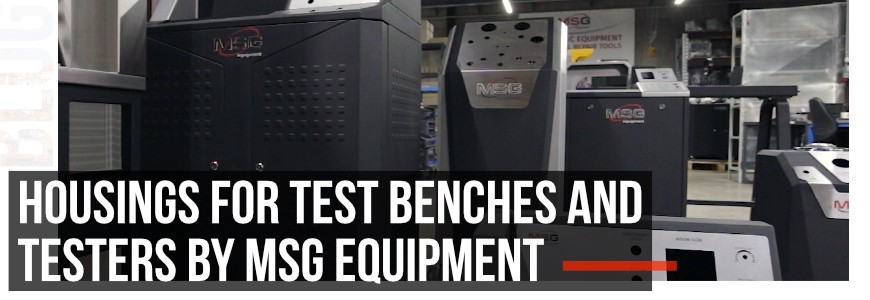
1. Engineering
2. Major characteristics
3. Design
4. Bending of metal sheets with CNC presses
5. Installation of fixing elements
6. Corrosion-resistant coating
7. Logo and marking
8. Ergonomics
We aim to increase the degree of work process automation at car service stations, repair shops, and garages. MSG Equipment test benches minimize the amount of manual work and shorten the time of vehicle maintenance, diagnostics, and repair.
The process of housing design and manufacture is almost fully computer-assisted. Our specialists only design a 3D-model and do the assembly work, all the other processes are automated.
Engineering
At the initial stage of manufacture, we design a special 3D-model and make drawings of the future test bench housing. We decide on the size, design features, functionality, technology, and exterior of the housing. We carefully think through every element and component of the housing and make calculations.
Major characteristics of the housings for test benches and testers by MSG Equipment:
- corporate design;
- high strength;
- rigidity;
- lightweight;
- ergonomics;
- safety.
Design
Since the diagnostics of some vehicle units requires high force and torque, the test bench housings are designed to withstand heavy loads without turning out of shape. For example, Test Bench MS1000+ for diagnostics of shock absorbers tests any unit types under a load of 1000 kg.
In our test bench housings, we use framed tube structures with localized reinforcing elements. The majority of frame parts are manufactured by laser cutting with a special CNC machine. We use a laser to cut the construction elements of any shape and size. Depending on the material, we use either carbon dioxide laser welding or argon welding with a non-consumable electrode to couple the individual parts of the housing.
This method allows us to produce a lightweight one-piece construction that possesses the necessary strength and rigidity.
Bending of metal sheets with CNC presses
CNC bending presses are used to bend sheet metal. This technique enables us to implement the most daring design solutions yet providing the necessary structural stiffness to the housings, any secondary elements avoided.
Installation of fixing elements
All the housings of our test benches and testers have special fixing points for electric circuit boards, cable outlets, control panels, and other components. We use pressed-in or welded threaded fittings to embed radioelements and electronic components into the housings.
Corrosion-resistant coating
Either a paint or electrolyte coating is used to protect the metal housings against corrosion. Our specialists apply a powder coating technique to paint the housings. This technique has several advantages among which are the mechanical stability and possibility of use in any environmental conditions.
Besides, this coating technique makes the housings look more attractive, improves their electrical enclosure protection and surface wear-resisting properties. The use of a solvent-free paint makes this method environment-friendly. The parts of the housings exposed to aggressive substances, e.g. brake fluid, are made of stainless steel. This applies to our Test Bench MS300 for diagnostics of brake calipers.
Logo and marking
Our equipment is provided with marking that contains important information for operation of the test benches (for example, “Load”, “Drive speed”, “Voltage”) This marking must be clearly visible and easy-to-read. The logo and other information are inscribed with UV paint. Each tester or test bench is supplied with a product information plate with laser engraved unique item number and marking.
Ergonomics
The dimensions of the housings and location of all the components meet the ergonomic requirements and thus, ensure comfortable operation of the equipment. When configuring the elements of the housings, we pay considerable attention to the access openings, windows, and doors to provide easy maintenance of the equipment. Test Bench MS1000+ for diagnostics and repair of shock absorbers is a good example of the above-said.
Design and technology solutions used in the process of the housings manufacture are intended to prolong the service life of our equipment, ensure its convenience and operational safety.



COMMENTS